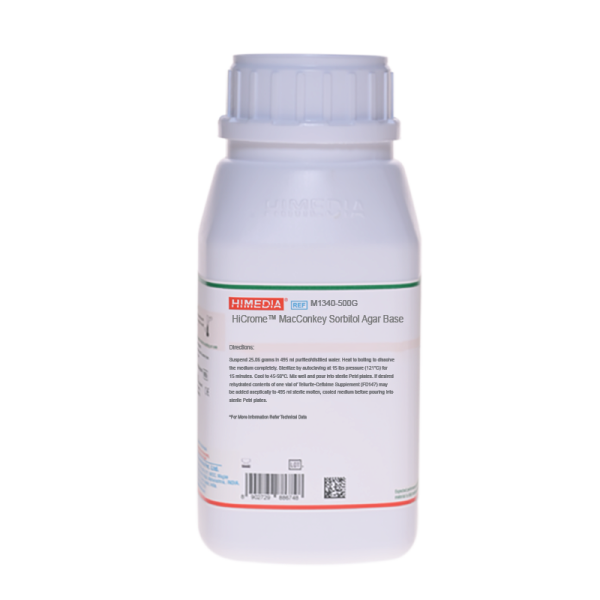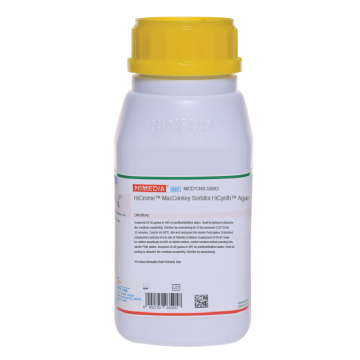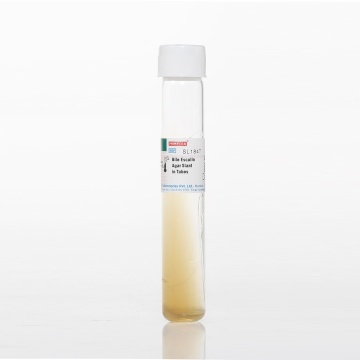 Your enquiry has been submitted
Your enquiry has been submitted
HiCrome™ MacConkey Sorbitol Agar Base
Intended Use:
Recommended for selective isolation of Escherichia coli O157:H7 from food and animal feeding stuffs.
Composition**
| Ingredients | g/L |
|---|---|
| Tryptone | 17.000 |
| Proteose peptone | 3.000 |
| Sorbitol | 10.000 |
| Bile salts mixture | 1.500 |
| Sodium chloride | 5.000 |
| Crystal violet | 0.001 |
| Neutral red | 0.030 |
| B.C. indicator | 0.100 |
| Agar | 13.500 |
Final pH (at 25°C): 7.1±0.2
**Formula adjusted, standardized to suit performance parameters
Directions
Suspend 25.06 gram in 495 ml purified/ distilled water. Heat to boiling to dissolve the medium completely. Sterilize by autoclaving at 15 lbs pressure (121°C) for 15 minutes. Cool to 45-50°C. Mix well and pour into sterile Petri plates. If desired rehydrated contents of one vial of TC Selective Supplement (FD147) may be added aseptically to 495 ml sterile molten, cooled medium before pouring into sterile Petri plates.
Principle And Interpretation
Sorbitol MacConkey Agar is based on the formulation described by Rappaport and Henig (1). The medium contains sorbitol instead of lactose and it is recommended for the detection of enteropathogenic strains of Escherichia coli O157:H7 that ferments lactose but does not ferment sorbitol (2) and hence produce colourless colonies. Sorbitol fermenting strains of Escherichia coli produce pink-red colonies. The red colour is due to production of acid from sorbitol, absorption of neutral red and a subsequent colour change of the dye when pH of the medium falls below 6.8. Escherichia coli O157:H7 has been recognised as a cause of haemorrhagic colitis (3). March and Ratnam (2) reported that the detection of Escherichia coli O157:H7 had a sensitivity of 100% and specificity of 85% on Sorbitol MacConkey Agar and they recommended this medium as reliable means of screening Escherichia coli O157:H7. B.C. indicator is added to detect the presence of an enzyme β-D-glucuronidase, which is specific for Escherichia coli (4). Strains of Escherichia coli fermenting sorbitol and possessing β-D-glucuronidase appear as blue – purple coloured colonies on the medium. Enteropathogenic strains of Escherichia coli O157:H7 do not possess β-D-glucuronidase activity (5) and do not ferment sorbitol, thus produce colourless colonies.
Tryptone and proteose peptone provide carbonaceous, nitrogenous compounds, long chain amino acids, vitamins and other essential growth nutrients. Most of the gram-positive organisms are inhibited by crystal violet and bile salts. Sodium chloride maintains the osmotic equilibrium.
Addition of Tellurite-Cefixime Supplement makes the medium selective (6). Potassium Tellurite selects the serogroups and inhibits Aeromonas species and Providencia species Cefixime inhibits Proteus species. Pseudomonas if present produces colourless colonies on this medium. For confirmation oxidase test may be performed with suspected colonies and results should be noted within 5-10 seconds.
Type of specimen
Clinical samples : Stool; Food samples
Specimen Collection and Handling
For clinical samples follow appropriate techniques for handling specimens as per established guidelines (7,8).
For food samples, follow appropriate techniques for sample collection and processing as per guidelines (9).
After use, contaminated materials must be sterilized by autoclaving before discarding.
Warning and Precautions
In Vitro diagnostic use. For professional use only. Read the label before opening the container. Wear protective gloves/protective clothing/eye protection/face protection. Follow good microbiological lab practices while handling specimens and culture. Standard precautions as per established guidelines should be followed while handling clinical specimens. Safety guidelines may be referred in individual safety data sheets.
Limitations
- β-glucuronidase is present in 97% of E.coli strains, however few E.coli may be negative.
- Some species may show poor growth due to nutritional variations.
- Further biochemical and serological test are necessary for confirmation.
Performance and Evaluation
Performance of the medium is expected when used as per the direction on the label within the expiry period when stored at recommended temperature.
Quality Control
Appearance Light yellow to pink homogeneous free flowing powder
Gelling Firm, comparable with 1.35% Agar gel.
Colour and Clarity of prepared medium Purplish red coloured, clear to slightly opalescent gel forms in Petri plates
Reaction Reaction of 5.01% w/v aqueous solution at 25°C. pH : 7.1±0.2
pH 6.90-7.30
Cultural Response
Cultural characteristics observed after an incubation at 35-37°C for 18-24 hours(48 if necessary)
| Organism | Inoculum (CFU) | Growth | Recovery | Colour of colony w/o addition of FD147 | Oxidase Reaction |
|---|---|---|---|---|---|
| Escherichia coli O157:H7 (NCTC 12900) | 50-100 | good-luxuriant | >=50% | colourless | negative reaction |
| Escherichia coli ATCC 25922 (00013*) | 50-100 | none-poor | <=10% | blue-green | negative reaction |
| Pseudomonas aeruginosa ATCC 27853 (00025*) | 50-100 | fair-good | 30-40% | colourless | positive reaction, deep purple blue colour develops within 10 seconds |
| Klebsiella pneumoniae ATCC 13883 (00097*) | 50-100 | none-poor | <=10% | pink-red | negative reaction |
Key: *Corresponding WDCM numbers.
Storage and Shelf Life
Store between 15-25°C in a tightly closed container and the prepared medium at 2-8°C. Use before expiry date on the label. On opening, product should be properly stored dry, after tightly capping the bottle in order to prevent lump formation due to the hygroscopic nature of the product. Improper storage of the product may lead to lump formation. Store in dry ventilated area protected from extremes of temperature and sources of ignition Seal the container tightly after use. Product performance is best if used within stated expiry period.
Disposal
User must ensure safe disposal by autoclaving and/or incineration of used or unusable preparations of this product. Follow established laboratory procedures in disposing of infectious materials and material that comes into contact with clinical sample must be decontaminated and disposed of in accordance with current laboratory techniques (7,8).
Reference
- Rappaport F. and Henigh E., 1952, J. Clin. Path., 5:361.
- March S.B. and Ratnam S. (1986): J. Clin. Microbiol. 23,869-872.
- Karmali M.A., Petric M., Lim C., et al, 1985, J. Infect. Dis. 151-775.
- Hansen W. and Yourassawsky E., 1984, J. Clin. Microbiol., 20:1177.
- Thompson et al (1990). J. Clin. Microbiol. 29, 2165-2168.
- Zadik P.M., Chapman P.A., and Siddons C.A. (1993), J. Med. Microbiol.39, 155-158.
- Isenberg, H.D. Clinical Microbiology Procedures Handbook. 2nd Edition.
- Jorgensen, J.H., Pfaller, M.A., Carroll, K.C., Funke, G., Landry, M.L., Richter, S.S and Warnock., D.W. (2015) Manual of Clinical Microbiology, 11th Edition. Vol. 1.
- Salfinger Y., and Tortorello M.L. 2015, Compendium of Methods for the Microbiological Examination of Foods, 5th Ed., American Public Health Association, Washington, D.C.
| Product Name | HiCrome™ MacConkey Sorbitol Agar Base |
|---|---|
| SKU | M1340 |
| Product Type | HiCrome™ |
| Physical Form | Powder |
| Origin | Animal |
| Packaging type | HDPE |
| References | 1. Hansen W. and Yourassawsky E., 1984, J. Clin. Microbiol., 20:1177. |
| Customized Product Available | No |








